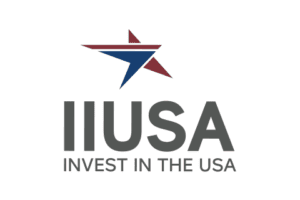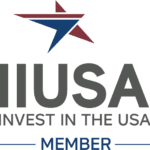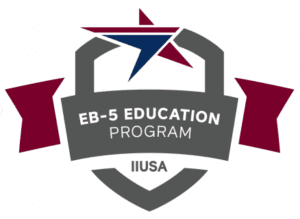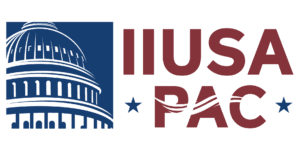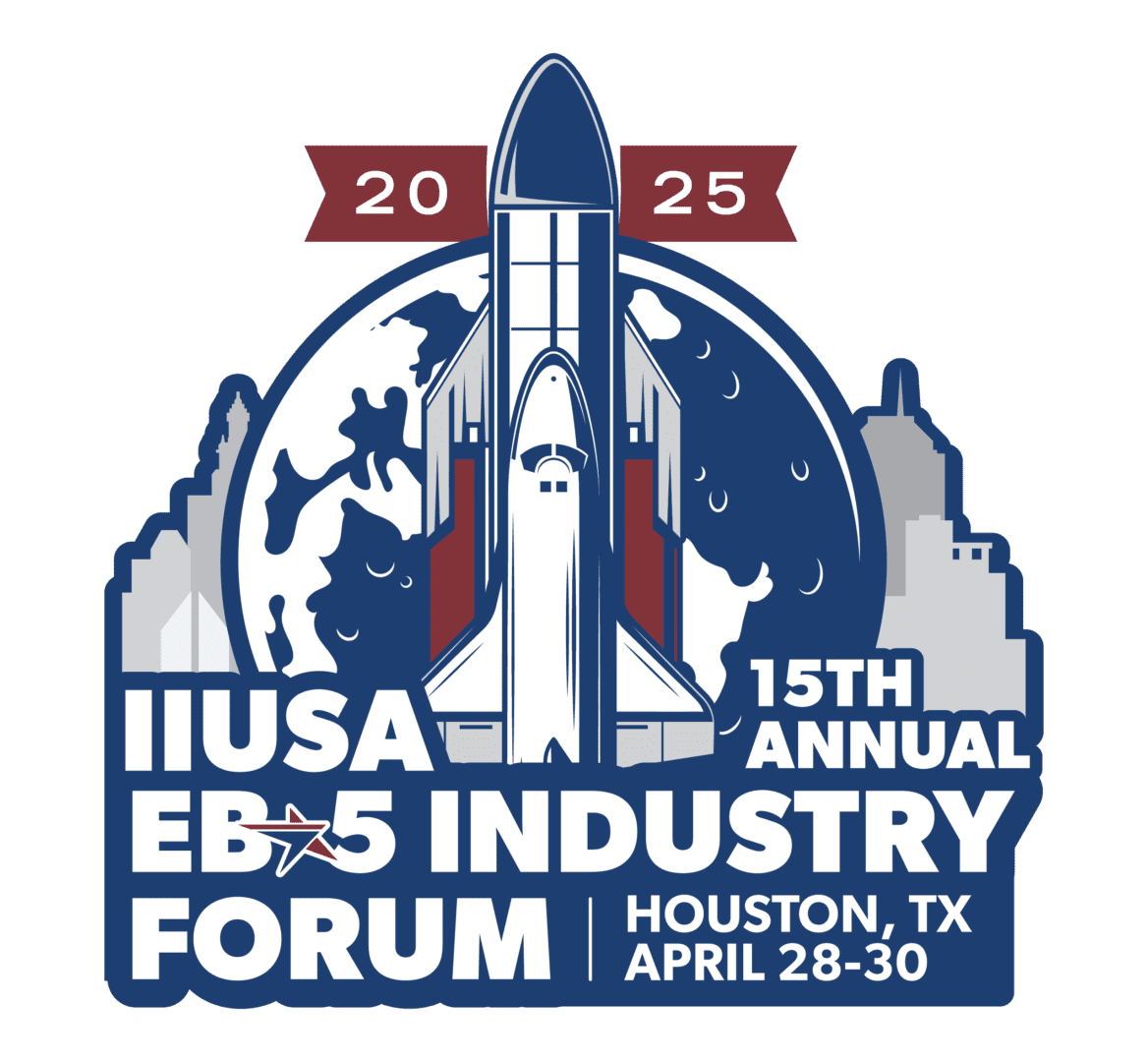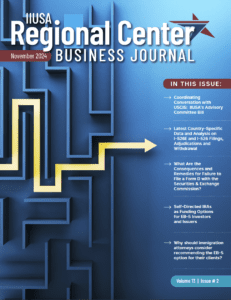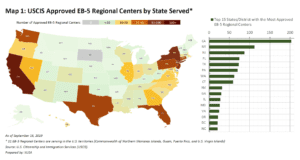Last week, Senators Grassley (R-IA) and Leahy (D-VT) introduced the “EB-5 Reform and Integrity Act of 2021“. The bill reauthorizes the EB-5 Regional Center Program for five years and assures much-needed reforms.
To ensure all EB-5 stakeholders are well informed IIUSA Member and Legislative Counsel, Carolyn Lee prepared the below section by section summary of the bill. We encourage all stakeholders to take a familiarize themselves with the information below.
Any questions, comments, or concerns on IIUSA’s advocacy push can be directed to advocacy@iiusa.org.
EB-5 Reform and Integrity Act 2021: Updated Section by Section Summary
Produced by Carolyn Lee, Partner Carolyn Lee, PLLC; Legislative Counsel, IIUSA
The below is a high-level section-by-section summary of the EB-5 Reform and Integrity Act of 2021 (the “Integrity Act” or the “Act”) sponsored by Senators Chuck Grassley (R-IA) and Patrick Leahy (D-VT) introduced today. This summary updates the prior summary of the EB-5 Reform and Integrity Act of 2020 introduced in December 2020 (“2020 Version”) and highlights noteworthy changes.
Most of the substantive amendments to the current Immigration Nationality Act (“INA”) section 203(b)(5) and the public law governing the regional center program are in Section 2 of the Integrity Act.
The Integrity Act is effective upon enactment except Section 2 which is effective 90 days after enactment. EB-5 investor petition eligibility will be determined at the time of filing. This means the Act will apply only to investor petitions filed on or after enactment without retroactive impact on pending investor petitions. Form I-829 petitions will be decided by the law under which the underlying I-526 petition was filed.
Purpose. The bill states its purpose as “[t]o authorize the EB-5 Regional Center Program in order to prevent fraud and to promote and reform foreign capital investment and job creation in American communities.”
SECTION 1. Short title. This section states the title of the proposed law, “EB-5 Reform and Integrity Act of 2021.”
SECTION 2. Reauthorization and Reform of the Regional Center Program. This section repeals the 1993 law creating the regional center program and is the “meat” of the Integrity Act. Substantive provisions are added onto existing INA 203(b)(5) which currently ends at subparagraph (D) with new subparagraphs (E) through (Q).
Subparagraph (E) Regional Center Program.
Subparagraph (E) incorporates the current regional center authorization statute. It contains standards for establishing a regional center, which will be required to include a description of the policies and procedures reasonably designed to ensure program compliance and monitor new commercial enterprises and job-creating entities.
Attestations confirming compliance with “good actor” provisions in subparagraph (H) will also be required. Ten percent (10%) of required jobs must be directly created but may be established by employees of the job-creating entity and estimated by economically valid methodologies. Regional centers are required to retain 5-year records and will be audited at least once every 5 years.
Updates:
Direct jobs. In an EB-5 project where construction is expected to last under 24 months, a different direct jobs formula applies. Under the current USCIS policy, when construction is expected to last under 24 months, all direct construction jobs are excluded. Under the Integrity Act, direct jobs in that context may be counted, but only a portion proportional to construction duration. The total number of direct jobs is to be multiplied by the fraction of 24 months the construction activity lasts and must total at least 25% of the required job creation.
“Substantive” not “significant” economic impact. The 2020 Version required a new regional center proposal to demonstrate that pooled investments will have a “significant economic impact”. In response to IIUSA’s concern regarding the absence of defining limit to the word “significant,” the Integrity Act replaces this term with “substantive,” a lower threshold.
Subparagraph (F) Business Plans for Regional Center Investments.
Subparagraph (F) requires regional centers to file business plans for specific projects, what we today call “exemplar” applications on the Form I-924. Importantly, the business plan need not be approved before investor petitions may be filed. There is a list of items required in the application, including material investment risks, material litigation, and information regarding fees paid by the regional center, new commercial enterprise, or any issuer of securities to agents, finders, and brokers involved in the offering.
Approved applications will be binding on associated petitions unless the petitioner is involved in fraud, or there is a material change, a mistake in prior adjudication, or national security-related or other adverse evidence is discovered.
Subparagraph (G) Regional Center Annual Statements.
Subparagraph (G) requires annual statements containing several certifications generally to the certifier’s knowledge after due diligence investigation. The regional center must certify that it is only involved with bona fide actors not precluded by subparagraph (H) and that it is in compliance with securities requirements set out in subparagraph (I) as well as promoter requirements in subparagraph (K).
In addition, an accounting of investor capital, each new commercial enterprise, including a description of use, progress toward completion, jobs created, and fees offered to parties engaged to locate investors will be required. Amendments will be required if the Secretary of the Department of Homeland Security (“DHS”) determines that the annual statement is deficient. Investors may request copies of annual statements and receive portions relevant to their investment.
Sanctions for failing to submit, knowing submission of untrue facts, or failure to conduct itself in accordance with its designation will subject a regional center to fines, temporary suspension, permanent bar, or termination.
Update:
Material disclosures. The Integrity Act limits required reporting regarding litigation or bankruptcy to “material” litigation or bankruptcy. As updated from the 2020 Version, the Act further clarifies that the “materiality” threshold for annual reporting applies also to litigation or bankruptcy resolved during the prior fiscal year.
Subparagraph (H) Bona Fides of Persons Involved with Regional Center Program.
Subparagraph (H) precludes persons failing to meet the bona fides requirements from involvement with a regional center, new commercial enterprise (“NCE”), or job-creating entity (“JCE”). A person is precluded if the person (1) has committed a crime or offense involving fraud, (2) is subject to an adverse order by a financial regulator, (3) would be barred under U.S. immigration inadmissibility laws, or (4) has been listed, disciplined or reprimanded for reasons including fraud.
A separate preclusion applies to a person who is not a U.S. national or a permanent resident. Foreign governments also may not fund or have any ownership or administration role over a regional center, NCE, or JCE, but a foreign investment fund owned by a sovereign wealth fund or foreign fund permitted to do business in the U.S. may be involved with the ownership, though not the administration of, a JCE.
Regional centers, NCE, and affiliated JCEs will be subject to provide information and fingerprints as well as background checks. Unaffiliated JCEs may be subject to the same if DHS has a reasonable basis to require such information.
Regional centers may be terminated and NCEs or JCEs debarred for knowingly involving a noncompliant person or failing to provide or knowingly providing false information.
Update:
Bona fide actor. A person who is subject of rescission or removal proceedings does not qualify as a bona fide actor for EB-5 program participation.
Subparagraph (I) Compliance with Securities Laws.
Subparagraph (I) requires compliance with U.S. and applicable State securities laws. It specifies the content of the initial and annual regional center certification, which must confirm compliance with securities laws to the best of the certifier’s knowledge after a due diligence investigation. Discovery of noncompliance is required to be reported along with remedial efforts and certification that the regional center and associated parties are back in compliance.
Significantly, the regional center’s oversight requirement now has a reasonableness standard. A regional center is required to use commercially reasonable effort to “monitor and supervise” securities transactions. In prior iterations of this provision, this obligation was open and undefined.
Update:
Compliance with securities laws. In response to IIUSA and EB-5 Securities Roundtable concerns, the Integrity Act specifies that required compliance with securities laws relates to using commercially reasonable efforts “to monitor and supervise compliance with the securities laws” and not to the potentially broader obligation “to confirm compliance with the securities laws” in the 2020 Version and earlier draft legislation. This change represents another important advancement in imposing reasonable limits to regional center oversight obligations.
Subparagraph (J) EB-5 Integrity Fund.
Subparagraph (I) creates a fund to monitor, investigate, ensure compliance, and to conduct audits and site visits. Starting October 1, 2021, the annual fee is $20,000 from each regional center, reduced to $10,000 for one with 20 or fewer total investors in the prior year. A failure to pay the fee will subject the regional center to a penalty and termination. The DHS will be required to submit an annual report describing the uses of the fund in the prior year.
Subparagraph (K) Direct and Third-Party Promoters.
Subparagraph (K) authorizes DHS to prescribe rules and standards for direct and third-party promoters (including migration agents) to oversee the promotion of EB-5 offerings. The rules and standards may include: registration with USCIS, certification of compliance with subparagraph (H)’s bona fides requirements, guidelines for accurately representing the visa process to investors, and guidelines describing permissible fee arrangements under securities and immigration laws.
Regional centers will be required to maintain a written agreement between the regional center, the NCE, any affiliated JCE, and direct and third-party promoters. Noncompliant promoters will be suspended or permanently barred from the EB-5 program.
Investors will be required to include in petitions a disclosure reflecting all fees and other compensation paid to any person including agents, finders, or broker-dealers to the extent not identified in the business plan.
Subparagraph (L) Source of Funds.
Subparagraph (L) requires business and tax records or similar records to be filed with form I-526, including tax returns of any kind filed during the past 7 years (or another period determined by the DHS) by or on behalf of the investor. The identity of all persons transfer funds into the U.S. on the investor’s behalf is required and any funds used to pay costs and fees associated with the investment, not limited to the capital investment, will need to be shown as lawfully sourced.
Gifts and loans now have a good faith requirement accompanied by an emphasis on disqualification of funds from impermissible sources including illegal activity. The donor’s records will be required in gift cases.
Subparagraph (M) Treatment of Good Faith Investors Following Program Noncompliance.
Subparagraph (M) provides substantive relief and procedures to preserve immigration benefits for investors associated with terminated or debarred EB-5 entities. Under subparagraph (M), when a regional center is terminated or NCE or JCE debarred, DHS will notify investors. Investors will be given 180 days then to file an amendment or file a notice with DHS to confirm or establish continued eligibility.
Within 180 days, the NCE can affiliate with a regional center in good standing, if the associated regional center is terminated. If the NCE is debarred, the investor can associate with an NCE in good standing. Additional investment is needed solely to the extent necessary to satisfy job creation. Amendments may be filed without being deemed material change and recovered funds may be used to meet EB-5 requirements.
Investors will retain their priority dates and, significantly, children will be protected from age-out.
None of these benefits apply if the investor was a knowing participant in the conduct leading to the termination or debarment.
Subparagraph (N) Threats to the National Interest.
Subparagraph (N) requires DHS to deny or revoke EB-5 benefits including approved petitions, designations, and exemplar applications if approval is contrary to the national interest of the United States for reasons relating to public safety or national security. If a regional center, NCE, or JCE has its participation in the EB-5 program terminated for national interest reasons, any person associated with the terminated entity will be permanently barred if the person was a knowing participant in the conduct leading to the termination.
DHS will provide notice of the denial or revocation. A U.S.-owned regional center, NCE, or JCE will receive an explanation for the determination unless the information is classified or prohibited. There is no judicial review of DHS’s decisions under this subparagraph.
Subparagraph (O) Fraud, Misrepresentation, and Criminal Misuse.
Subparagraph (O) allows DHS to deny or revoke EB-5 benefits upon determining that the benefit was predicated on fraud or criminal misuse. The DHS will provide notice of its determination.
Subparagraph (P) Administrative Appellate Review.
Subparagraph (P) provides for administrative appellate review by the Administrative Appeals Office (“AAO”) for any DHS determinations made under INA section 203(b)(5). There is judicial review to review a determination after exhaustion of all administrative appeals. This means if there is a denial or revocation, the decision must first be appealed with the AAO before seeking remedy in federal court.
Subparagraph (Q) Fund Administration.
Subparagraph (Q) requires separate accounts for all NCEs including the involvement of a fund administrator unless waived., and additional procedures for affiliated JCEs, In general, independent fund administrators will be required to monitor, track, verify, and approve fund transfers. Fund administrator retention may be waived if an NCE or affiliated JCE is controlled by or under common control of a registered investment advisor or broker-dealer. The DHS will grant a waiver in other instances involving an annual independent financial audit.
Effective Date.
Section 2 of the Integrity Act will take effect 90 days after enactment.
SECTION 3. Conditional Permanent Resident Status for Alien Entrepreneurs, Spouses, and Children. This section amends INA section 216A, which governs the removal of conditions on residence. A petition for the removal of conditions is made on the Form I-829.
A key amendment to Section 216A is that if the required jobs are not all created at the time of filing the Form I-829, investors will have 1 additional year to create the remaining jobs. If the additional year is needed, the investor’s capital also must be invested during that time.
A defrauded investor who makes a second investment in accordance with subparagraph (M) may file for removal of conditions during the 90-days before the second anniversary of the subsequent investment, though the procedural mechanics of this intended benefit will need to be sorted out.
Site visits will need to have been performed as part of the removal of conditions requirements.
Finally, the law of the associated Form I-526 at the time of its filing will govern the law under which the Form I-829 is decided.
SECTION 4. EB-5 Visa Reforms. Section 4 adds new defined terms, including “affiliated job-creating entity,” “job-creating entity,” and “certifier.” An “affiliated job-creating entity” is a JCE that is controlled, managed, or owned by any of the people involved with the regional center or NCE.
The definition of “capital” is greatly expanded to list excluded assets including those acquired unlawfully, debt arrangements between the investor and the NCE, and capital invested with a guaranteed return or mandatory redemption. The capital definition also explicitly includes capital subject to an NCE buy-back option that results in petition withdrawal unless the investor has fulfilled his or her sustainment period.
Section 4 provides further age-out protection for children of investors whose conditional residence is terminated under section 216A or the new subparagraph (M), where the investor files a subsequent EB-5 petition. The dependent must remain unmarried and the second I-526 petition must be filed not later than 1 year after the termination of conditional residency.
Concurrent filing of EB-5 petitions and adjustments of status applications will now be permitted in cases of immediate visa availability, and EB-5 petitions will also get the same reprieve for status violations for 180 days or less under INA section 245(k). These provisions bring EB-5 more in-line with benefits afforded to other employment-based immigrants.\
Update:
New commercial enterprise definition. In response to IIUSA advocacy, the “new commercial enterprise” definition in the Integrity Act now aligns with the definition in the current regulations. The expanded definition includes holding companies and their wholly-owned subsidiaries.
Job-creating entity definition. Similarly, the “job-creating entity” definition now aligns with the more expansive “new commercial enterprise” definition but does not incorporate the requirement of being a for-profit organization. Nonprofit and publicly-owned entities continue to qualify as job-creating entities.
SECTION 5. Procedure for Granting Immigrant Status. An EB-5 petitioner must establish eligibility at the time of filing. This means that pending petitions will be decided by the law in place at the time of their filing. Petitions filed under the regional center program as amended by the new subparagraph (E), will establish eligibility under the Integrity Act and be subject to the approval of an exemplar approved under the new subparagraph (F).
Importantly as now explicitly set forth in Section 5, the DHS will continue to adjudicate petitions during the implementation of the Integrity Act.
SECTION 6. Timely Processing. Not less than 1 year after enactment, the Director of United States Citizenship and Immigration Services (“USCIS”) will complete a fee study. After completing the fee study, the Director will be required to set fees at a level to process petitions according to the schedule in Section 6, including 180 days for initial regional center designations and investment/exemplar applications, 240 days for investor petitions, and 90 and 120 days, respectively, for the same filings based on targeted employment area investments.
SECTION 7. Transparency. DHS employees will be required to act impartially without preferential treatment. Written and oral communications are required to be kept in the record of proceedings and logs also maintained. Communication from a third party may not be made a part of the record without notice and the opportunity to respond. Law enforcement information may also not be made a part of the record without consent.
An e-mail account will be maintained for case-specific inquiries as well as for general program information. Channels of communication will be limited to e-mail, the National Customer Service Center, or the Office of Public Engagement. IF anyone receives information that is not case-specific about program requirements that are not publicly available, USCIS will publish the information on the USCIS website as an update. Graduated sanctions will be established for violations.

